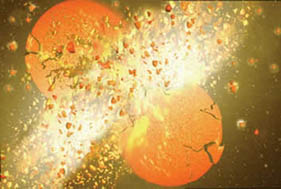|
|
|
 |
An artist’s rendering of a possible collision scenario between two huge asteroids or tiny planets. UF astronomers say such a collision may be the cause of the lopsided appearance of Beta Pictoris |
|---|
An article about the discovery appeared in the journal Nature.
“What we’re proposing is that a planetesimal — either a very small planet or a very large asteroid — has collided with another similar object and has been catastrophically destroyed,” said Charlie Telesco, a UF astronomy professor and the paper’s lead author. “It’s a cloud now, but what we’re proposing is that this cloud represents the debris of a major collision.”
The findings are of interest because they suggest a new explanation for a phenomenon — asymmetries or lopsided appearances in star dust discs — that has long puzzled astronomers, Telesco said. The results also continue to help refine the evolving science of planet-finding, an endeavor that has turned up more than 100 planets outside our solar system since the first was discovered in 1995.
Stars are thought to form when gravity causes a rotating cloud of gas to contract. Before the actual star is formed, the gas collapses into a rotating disk of gas and dust particles ranging in size from tiny grains to household-sized dust to rocks and boulders. Astronomers had long predicted that some of this material might coagulate into planets as it rotates around the core, but Beta Pictoris, first detected by the Infrared Astronomy Satellite in 1983, was the first such “circumstellar” star to be imaged.
Beta Pictoris is about 63 light-years from Earth in the southern constellation known as Pictor, or Painter’s Easel. It barely clears the horizon on the southern edges of the Northern Hemisphere, where it is seen most easily from Hawaii.
Like other planet-forming stars, Beta Pictoris, which is between 10 million and 20 million years old, is extremely young by stellar standards, with mature stars living billions of years. Also like some other young stars, it has an attribute that has long proved puzzling to astronomers: One side, or “wing,” of the star’s 200-billion-mile diameter dust disc is both brighter and longer than the other.
Some astronomers theorized that this anomaly was caused by the presence of a large planet orbiting the star. But the UF-led team came to a different conclusion after observing Beta Pictoris during six nights in December 2003 and last January using the Gemini telescope. The telescope had been specially equipped with a UF-designed and -built observational camera called the Thermal Region Camera and Spectograph, or T-ReCS, according to Telesco.
T-ReCS allows astronomers to detect faint sources of thermal or infrared radiation by isolating them from the far more powerful and more obvious radiation generated by the Earth’s atmosphere, the telescope and the star itself.
“We’re able to see sources that are at least a million times fainter than the background,” Telesco said. “It’s like trying to detect a match when you’re actually holding the match up to the sun.”
What Telesco characterized as “the most complete and the best resolution imaging at multiple wavelengths” of the star revealed that the wing’s brightness stemmed from a “knot” of emissions, or clump. Further examination showed this clump contained a higher concentration of smaller, finer dust particles than elsewhere, suggesting a violent and recent collision of asteroids or tiny planets.
“Many of us remember pounding chalk dust out of erasers at school,” said Scott Fisher, an astronomer at Gemini South and a co-author of the Nature paper. “After you sneeze a few times, you open a window and the fine dust blows away. In Beta Pictoris, the radiation from the star should blow away the fine particles from the collision quite rapidly. The fact that we still see them in our observations means that the collision probably happened in the past 100 years or so.”
Charlie Telesco, telesco@astro.ufl.edu
Aaron Hoover
